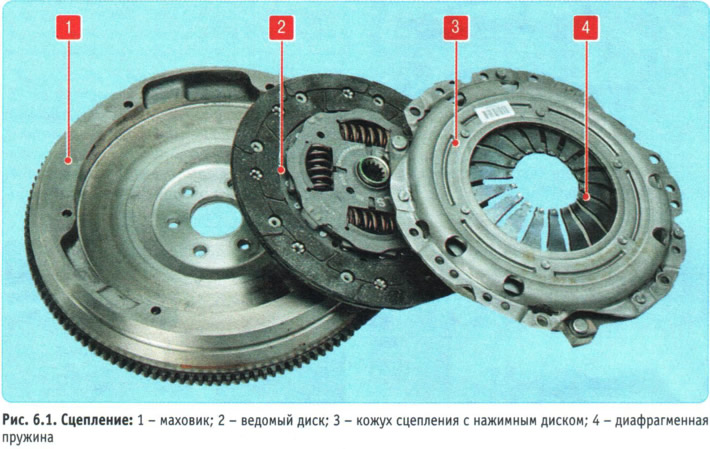
The pressure plate is mounted in a stamped steel casing 3 (pic. 6.1), attached with six bolts to the flywheel 1 of the engine.


The driven disk 2 is mounted on the splines of the input shaft of the gearbox and is clamped by a diaphragm spring 4 between the flywheel and the pressure disk.
Bearing 2 (pic. 6.2) clutch release is structurally integrated with the working cylinder 3, attached with three bolts 4 to the clutch housing 1.

The hydraulic clutch release actuator consists of the following elements...

... the master cylinder installed in the engine compartment...

...working cylinder 3 (see fig. 6.2), combined with the clutch release bearing...

... a pipeline consisting of hose A and tube B...

... and a clutch pedal, the bracket of which, common with the brake pedal, is attached with nuts to the front end shield of the body.

The rod of the master cylinder of the clutch release actuator is connected to the pedal with a special plastic spring retainer.
NOTE: Shown with the pedal assembly removed for clarity.
The master cylinder is connected by a hose to a reservoir mounted on the brake master cylinder (reservoir common to both master cylinders). The hydraulic clutch release uses brake fluid. Adjustment of the clutch release drive is not provided, it is only possible to check the clutch pedal travel in order to determine the technical condition of the clutch.
USEFUL ADVICE: In order for the clutch to serve for a long time and without fail, do not constantly keep your foot on the clutch pedal. This bad habit is often acquired while learning to drive in driving schools for fear of not having time to turn off the clutch while the car is stopped. In addition to the rapid fatigue of the foot, which is all the time above the pedal, the clutch is at least a little, but squeezed out, and the driven disk slips and wears out. In addition, although the release bearing is designed to operate in constant rotation mode, when the pedal is pressed a little, it is under increased load, and its life is reduced. For the same reason, we do not recommend keeping the clutch in the off position for a long time (e.g. in traffic jams). If you do not have to immediately move away, it is better to put the gearbox in neutral and release the pedal.
Clutch slip can be easily determined with a tachometer. If, while driving, with a sharp press on the accelerator pedal, the speed rises sharply, and then drops a little and the car starts to accelerate, the clutch needs to be repaired.
